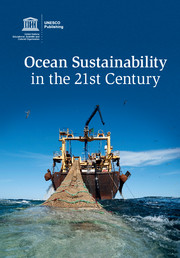Book contents
- Frontmatter
- Contents
- List of contributors
- Acronyms and abbreviations
- Foreword by Irina Bokova, Director-General of UNESCO
- Foreword by Thomas E. Lovejoy
- Preface
- Acknowledgements
- 1 Issues regarding oceans and opportunities: an introduction to the book
- 2 Main human uses of ocean areas and resources, impacts, and multiple scales of governance
- 3 Physical and chemical changes in the ocean over basin-wide zones and decadal or longer time-scales: perspectives on current and future conditions
- 4 Knowledge and implications of global change in the oceans for biology, ecology, and ecosystem services
- 5 A new perspective on changing Arctic marine ecosystems: panarchy adaptive cycles in pan-Arctic spatial and temporal scales
- 6 Ecosystem approach and ocean management
- 7 Challenges in using valuation in ecosystem-based management in a marine context: the case of UK Marine Protected Area designation
- 8 The contribution of international scientific cooperation and related institutions to effective governance for the oceans: the cases of regional tsunami early warning systems and the Argo project
- 9 Emerging and unresolved issues: the example of marine genetic resources of areas beyond national jurisdiction
- 10 The assumption that the United Nations Convention on the Law of the Sea is the legal framework for all activities taking place in the sea
- 11 The legal regime of outer space in light of the Law of the Sea
- 12 Towards sustainable oceans in the 21st century
- Index
- References
4 - Knowledge and implications of global change in the oceans for biology, ecology, and ecosystem services
Published online by Cambridge University Press: 05 May 2015
- Frontmatter
- Contents
- List of contributors
- Acronyms and abbreviations
- Foreword by Irina Bokova, Director-General of UNESCO
- Foreword by Thomas E. Lovejoy
- Preface
- Acknowledgements
- 1 Issues regarding oceans and opportunities: an introduction to the book
- 2 Main human uses of ocean areas and resources, impacts, and multiple scales of governance
- 3 Physical and chemical changes in the ocean over basin-wide zones and decadal or longer time-scales: perspectives on current and future conditions
- 4 Knowledge and implications of global change in the oceans for biology, ecology, and ecosystem services
- 5 A new perspective on changing Arctic marine ecosystems: panarchy adaptive cycles in pan-Arctic spatial and temporal scales
- 6 Ecosystem approach and ocean management
- 7 Challenges in using valuation in ecosystem-based management in a marine context: the case of UK Marine Protected Area designation
- 8 The contribution of international scientific cooperation and related institutions to effective governance for the oceans: the cases of regional tsunami early warning systems and the Argo project
- 9 Emerging and unresolved issues: the example of marine genetic resources of areas beyond national jurisdiction
- 10 The assumption that the United Nations Convention on the Law of the Sea is the legal framework for all activities taking place in the sea
- 11 The legal regime of outer space in light of the Law of the Sea
- 12 Towards sustainable oceans in the 21st century
- Index
- References
Summary
4.1 Introduction
There is an increasing awareness that the Earth is changing, but it is still unknown whether these changes occur cyclically, stochastically, episodically, or are long-term trends. The contemporary global climate change is a reality and a result of human activities that annually release gigatonnes of carbon into the Earth's atmosphere (IPCC, 2007; Hansen et al., 2007). Direct consequences of cumulative post-industrial emissions include increasing global temperature, perturbed regional weather patterns, rising sea levels, acidifying oceans, decreasing oxygen concentration, changed nutrient loads, and altered ocean circulation (Brierley and Kingsford, 2009). All of these factors cause climate change to have different effects on marine ecosystems, their function, biodiversity, and on the goods and services that they can provide. These contribute to human welfare, both directly and indirectly, and represent part of the total economic value of the planet (Costanza et al., 1997); therefore, the loss of these goods and services has important social and economic implications. Also deepsea ecosystems, which have long been thought to be extremely stable in terms of physico-chemical conditions, may experience abrupt change and climate-driven temperature shifts as a direct consequence of the prevailing surface climate conditions (Smith et al., 2009; Masuda et al., 2010; Fahrbach et al., 2011). Contemporary climate change has the potential to perturb ocean circulation on a time-scale far shorter than that of continental drift. For example, a reduction in the North Atlantic Current could have major implications for northern Europe and beyond during this century (Cunningham et al., 2007). This emphasizes the importance of regional considerations versus global generalization of the ‘global warming’ paradigm (Brierley and Kingsford, 2009). Climate-induced changes strongly differ across the globe, especially along a latitudinal gradient. Warming appears more pronounced at the poles than at the equator, and the responses of climate change are expected to differ for different marine habitats (Hoegh-Guldberg and Bruno, 2010; McGinty et al. 2011). For example, whilst open oceans are more affected by the in fluence of wind on the timing and strength of stratification, coastal areas are expected to be more vulnerable to the effects of wind due to storms.
- Type
- Chapter
- Information
- Ocean Sustainability in the 21st Century , pp. 84 - 108Publisher: Cambridge University PressPrint publication year: 2015
References
- 1
- Cited by



